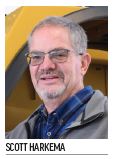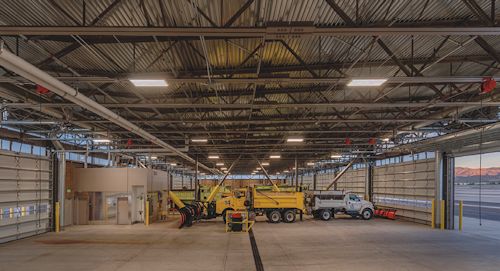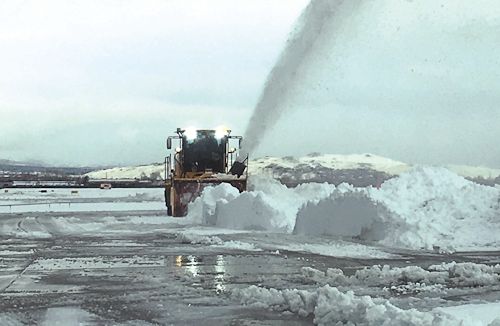As the gateway to world-famous ski slopes, big-name casinos and other popular tourist attractions, Reno International Airport (RNO) is under a lot of pressure to remain open 24/7 throughout the year, regardless of weather. Multiple departments band together to face the challenge head-on, but responsibility for clearing snow and ice off the runways falls on Airfield Maintenance Superintendent J. Scott Harkema and his staff.
As the gateway to world-famous ski slopes, big-name casinos and other popular tourist attractions, Reno International Airport (RNO) is under a lot of pressure to remain open 24/7 throughout the year, regardless of weather. Multiple departments band together to face the challenge head-on, but responsibility for clearing snow and ice off the runways falls on Airfield Maintenance Superintendent J. Scott Harkema and his staff.
 “One of the key reasons our process works so well is that RNO is small enough that everyone involved in the process is on a first-name basis, and we all share a passion for safety and constant process improvements,” says Harkema. “They work hard, take ownership of their work and take a great deal of pride in what they do. Good equipment and technology are vital to effective airfield snow removal, but teamwork gets the job done.”
“One of the key reasons our process works so well is that RNO is small enough that everyone involved in the process is on a first-name basis, and we all share a passion for safety and constant process improvements,” says Harkema. “They work hard, take ownership of their work and take a great deal of pride in what they do. Good equipment and technology are vital to effective airfield snow removal, but teamwork gets the job done.”
When a big snowstorm is imminent, teams all over the airport snap into action. “Due to rapidly changing conditions, real-time National Weather Service data is communicated to the snow teams. This data is used for everything from long-term manpower forecasting to determining the best time to break the crews for lunch,” he explains. “The air traffic control tower receives real-time field condition reports from Airside Ops, and works with the snow teams to spread traffic to enable snow removal operations. The Snow Desk sends weather and condition updates to tenants, pilots and the control tower. RNO Public Affairs uses the media and social media to get relevant information out to the traveling public.”
|
Project: Snow Removal Operations Location: Reno (NV) Int’l Airport Est. 2017 Volume: 4 million passengers Airport Altitude: 4,400 feet Average Annual Snowfall: 24 inches Snow Season: Sept. to May Maintenance Staff: 27 people Snow Equipment: 29 vehicles
Weather Data: Nat’l Weather Service; Keys for Success: Teamwork & pride of removal crews; coordination among multiple airport departments; modern equipment & storage facility Airside Snow Removal Equipment 2011 Oshkosh/MB 22’ Snow Broom Two Oshkosh 20’ Snow Brooms (1996 & 1997) Three 2017 Larue 22’ Snow Brooms Two 2006 Larue Snow Blower (5,000 & 7,500 ton/hr)
Two 2015 Oshkosh Trucks with 22’ Plows
2012 Oshkosh Truck with 22’ Plow/Scraper 2004 Ford F650 Truck with 11’ plow & 4-yd. sander
2008 John Deere 328 Skid Steer with 10’ Plow 2014 Caterpillar 966M Loader with 26’ Winged Plow 1994 Caterpillar 966F Loader with 20’ Box Plow 1986 Ford Jet Air Truck 2006 MB 16’ Snow Broom, towed by 2009 Dodge 5500 2006 Haige 90’ Boom Deicer/Light Plow-2000 gal. Kueper Blades Landside Snow Equipment 2004 Dodge Plow/Sander Two GMC 1-ton Plow/Sanders (1998 & 1994) 1993 Bobcat 543B Loader 2004 Ford F-550 1-ton with dump bed Two 2005 Bobcat Skid Steer S300 Loaders Two 2005 Bobcat Toolcats |
Harkema, who has worked at the Nevada airport for 34 years, considers its location both a blessing and a challenge. “We don’t get buried in snow, as is the case for some of the snowbelt cities east of the Great Lakes; we average only about 24 inches a year,” he says. “But at a 4,400-foot altitude, the snow season runs from September to May.”
While large mountains due west of the airport tend to block some of the snow, the biggest weather fronts come in from the south and north. That means RNO occasionally gets socked by monster storms. “In 1990, we had 18 inches in one day,” Harkema recalls. “In 2005, we had to plow for 17 straight days.”
Culture of Readiness
Harkema firmly believes that being prepared to handle any situation requires considerable advance planning. “The work begins well before the first snow event,” he says. “Each year, the Airport Operations Department hosts a preseason luncheon with participants from its staff, the National Weather Service, air traffic control tower, landside and airside snow removal departments and executive management. Leaders introduce new team members, debrief operations from the previous winter and discuss any changes for the upcoming season.”
Input from the National Weather Service is especially helpful, Harkema relates. “They not only participate, they also provide a speaker for the meeting to discuss upcoming forecasts.”
The Airside Operations Department also holds similar, but smaller, preseason meetings with airport tenants.
In early fall, before the first storm hits, the Airfield Maintenance staff performs several test runs. “We practice a lot in the preseason,” Harkema says. “New drivers ride with senior operators, and the lead plow is always operated by a very senior driver. Less experienced crew members are positioned in the middle, flanked by an experienced driver at the back.”
The overriding mission is to have the right resources, in the right place, at the right time, throughout the snow removal season. Communication is critical to ensuring this occurs, Harkema emphasizes.
“We can clear our main 11,000-foot runway in less than 20 minutes,” he reports. “We use a convoy of three brooms, two trucks and one blower. There is usually a six-man crew, plus one mechanic. Another three blowers are used on ramps and taxiways. We have our own radio frequency, so everyone can talk to each other throughout the operation.”
The 27-person maintenance staff is split in two 12-hour shifts, with employees working on call. Staff is summoned well before a big storm hits to ensure that blocked roads do not leave the airport shorthanded. During extended weather events, crews are housed in two hotels—one on-site, another just across the street.
A 4- or 5-inch snowstorm, however, is considered no big deal. “I sit down with the Ops staff, as well as the National Weather Service, and we decide when to put people on standby. We might call in 10 or 11 people [for that kind of storm],” Harkema says. “Besides snow, we sometimes have nasty icing conditions, or bad windstorms, and have to be prepared for those as well.”
Keeping the public informed about possible weather delays is part of Brian Kulpin’s responsibilities as vice president of marketing and public affairs. Kulpin is alerted about any delays and cancellations, and he spreads the word via the airport website, social media apps, phone interviews with the media or press conferences, if necessary. “Fortunately, the National Weather Service forecasting is more accurate than ever,” he says. “They also use social media apps, so we know right away when something changes.”

Harkema reports that the various departments at RNO do a terrific job working with each other. “Communication is now the best it has ever been since I have been here,” he remarks.
Despite the area’s sometimes-unpredictable climate, the airport rarely closes completely. “In all the years I have worked here, we had to close the airport only twice,” Harkema says. “The airlines know we have a great team here. They rely on us to do our part. And the pilots that regularly fly here are used to the conditions and can handle occasional delays.”
Ongoing Equipment Upgrades
The airport has a fleet of nearly 30 vehicles from a wide number of manufacturers. (For a complete list, see Page 24.) With equipment vintages ranging from 1986 to 2017, crews typically use the older machines for landside tasks and the new machines for runways and other airfield pavement.

In December, the airport took delivery of three new Larue snow brooms. The T95 FB 22s feature 22-foot brooms and twin directional, high-velocity air blowers at the rear. “This is one of our most popular models,” says David Robichaud, international sales representative for J.A. Larue.
 “The tendency for international airports today is to have high-speed blowers, with a large capacity,” he says. “Our T95 blower can run at speeds of up to 25 mph. Airports like to have a 10,000-foot runway cleared in 20 minutes or so. With 1,320 horsepower, the T95 can blow snow 100 to 150 feet away from the pavement. The broom can be angled left or right, and the operator can choose different angles.”
“The tendency for international airports today is to have high-speed blowers, with a large capacity,” he says. “Our T95 blower can run at speeds of up to 25 mph. Airports like to have a 10,000-foot runway cleared in 20 minutes or so. With 1,320 horsepower, the T95 can blow snow 100 to 150 feet away from the pavement. The broom can be angled left or right, and the operator can choose different angles.”
The machine also can be used for rubber removal. It has a non-caustic releasing agent designed to prevent damage to concrete and protect painted airfield markings.
The base price for the Larue T95 FB 22 is more than $600,000, but various optional equipment can boost the cost considerably. Popular options include automatic rear steering, spare wheel, air conditioning, all periphery heated glasses (except windshield), AM/FM radio with CD player and a deluge system.
Training for new buyers such as RNO occur at the company’s factory in Quebec or on-site at the airport. “For an experienced driver or mechanic, it usually takes eight to 16 hours of training,” says Robichaud.
He recently completed training for operators at Jeju International Airport in South Korea. “They were gearing up for the 2018 Winter Olympics,” he explains, noting that Larue has many overseas customers.
Modern Storage Facility
RNO’s new Larue vehicles and other pieces of snow removal equipment are housed in a well-appointed storage and maintenance facility that opened in spring 2012. The 33,700-square-foot building features 22 bays with door actuators for each plow, and a boiler-heated hydronic radiant floor that helps maintain the building at 50 degrees Fahrenheit. The concrete apron around the building is also heated with this system. An automated venting system provides CO2 monitoring, and lighting turns on and off via motion sensors. The facility also includes five hot pressure wash stations with water bibs and air hose reels.
The modern facility not only provides a conducive environment for maintenance and repairs, it also keeps the fleet ready for deployment. Once the Operations staff and control tower make a request for a runway to be cleared, Harkema’s team is ready to go.
Local Conditions
“We are lucky that we are a popular destination for many types of travelers, and our annual traffic numbers support that,” says Kulpin. Last year, RNO served an estimated 4 million passengers, and airlines added capacity for 2,000 more seats. In late November, the airport welcomed a new carrier, Frontier, with routes from Reno to Denver.
 Unlike many newer airports, which are located outside the cities they serve, RNO is at the epicenter of its region. “We are only five minutes from the main downtown strip,” says Kulpin. “The city was basically built around the airport. So any traveler who wants to visit all the attractions downtown can be there in no time.”
Unlike many newer airports, which are located outside the cities they serve, RNO is at the epicenter of its region. “We are only five minutes from the main downtown strip,” says Kulpin. “The city was basically built around the airport. So any traveler who wants to visit all the attractions downtown can be there in no time.”
Lake Tahoe’s ski resorts are only a 45-minute drive away; in winter passengers even can see a few ski runs right from the airport. The main terminal, in fact, was built specifically for the 1960 Winter Olympics in Squaw Valley, CA.
Although RNO’s relatively high altitude can lead to unpredictable weather, it also has its advantages. “At an elevation of 4,400 feet, the weather conditions can change quickly. But on the plus side, we get 310 sunny days a year. Bright sun at altitude will melt snow quite a bit faster than at sea level,” Kulpin explains. “With our modern equipment and our excellent maintenance staff, we can get rid of snow here fairly quickly.”



